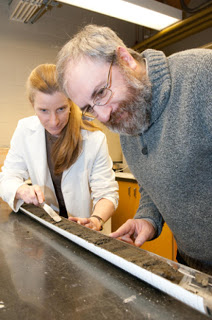
Understanding the size and frequency of large earthquakes along the Pacific coast of North America is of great importance, not just to scientists, but also to government planners and the general public. The only way to predict the frequency and intensity of the ground motion expected from large and giant “megathrust ” earthquakes along Canada’s west coast is to analyze the geologic record.
A new study published today in the Canadian Journal of Earth Sciences presents an exceptionally well-dated first record of earthquake history along the south coast of BC. Using a new high-resolution age model, a team of scientists meticulously identified and dated the disturbed sedimentary layers in a 40-metre marine sediment core raised from Effingham Inlet. The disturbances appear to have been caused by large and megathrust earthquakes that have occurred over the past 11,000 years.
One of the co-authors of the study, Dr. Audrey Dallimore, Associate Professor at Royal Roads University explains: “Some BC coastal fjords preserve annually layered organic sediments going back all the way to deglacial times. In Effingham Inlet, on the west coast of Vancouver Island, these sediments reveal disturbances we interpret were caused by earthquakes. With our very detailed age model that includes 68 radiocarbon dates and the Mazama Ash deposit (a volcanic eruption that took place 6800 yrs ago); we have identified 22 earthquake shaking events over the last 11,000 years, giving an estimate of a recurrence interval for large and megathrust earthquakes of about 500 years. However, it appears that the time between major shaking events can stretch up to about a 1,000 years.
“The last megathrust earthquake originating from the Cascadia subduction zone occurred in 1700 AD. Therefore, we are now in the risk zone of another earthquake. Even though it could be tomorrow or perhaps even centuries before it occurs, paleoseismic studies such as this one can help us understand the nature and frequency of rupture along the Cascadia Subduction Zone, and help Canadian coastal communities to improve their hazard assessments and emergency preparedness plans.”
“This exceptionally well-dated paleoseismic study by Enkin et al., involved a multi-disciplinary team of Canadian university and federal government scientists, and a core from the 2002 international drill program Marges Ouest Nord Américaines (MONA) campaign,” says Dr. Olav Lian, an associate editor of the Canadian Journal of Earth Sciences, professor at the University of the Fraser Valley and Director of the university’s Luminescence Dating Laboratory. “It gives us our first glimpse back in geologic time, of the recurrence interval of large and megathrust earthquakes impacting the vulnerable BC outer coastline. It also supports paleoseismic data found in offshore marine sediment cores along the US portion of the Cascadia Subduction Zone, recently released in an important United States Geological Survey (USGS) paleoseismic study by a team of researchers led by Dr. Chris Goldfinger of Oregon State University.
In addition to analyzing the Effingham Inlet record for earthquake events, this study site has also revealed much information about climate and ocean changes throughout the Holocene to the present. These findings also clearly illustrate the importance of analyzing the geologic record to help today’s planners and policy makers, and ultimately to increase the resiliency of Canadian communities. ”
Note : The above story is reprinted from materials provided by Canadian Science Publishing (NRC Research Press).










